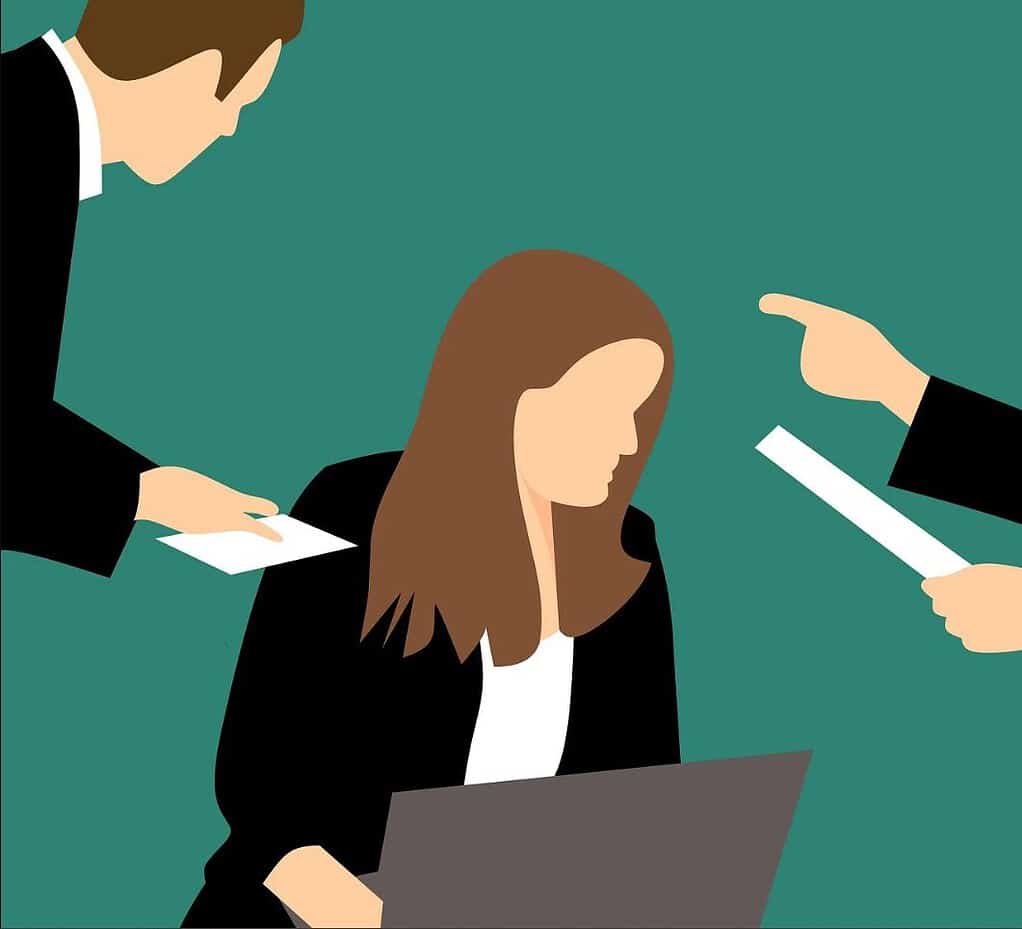This post was originally written in 2015 and has since been updated with new research, examples, and advice.
Pretend you’re a caveman.
You’re in your cave preparing for a hunt, but something outside seems dangerous. You hear violent sounds you don’t understand.
You have two choices: Skip the hunt, spend the night hungry, but live another day; or risk death and go outside.
Hold onto that thought. We’ll be getting back to that.
Now, imagine you’re driving to work. While getting off the highway, someone cuts you off. You slam on your brakes. You know the feeling that’s coming. Tense anger rises up. Your fingers clench the steering wheel.
It’s enough to make you feel horrible all day. You might be less productive at work and distracted during meetings. You might try to counterbalance that negative thinking or feeling with a quick shot of endorphins from junk food, mindless web surfing, or time-wasting YouTube videos.
This only compounds the problem.
This is like taking short-term unhappiness and investing it in a long-term, high-yield unhappiness investment plan, ensuring belly flab and career stagnation for years to come.
So why does this one minor thing—getting cut off—have such a powerful effect on us? Why does a few negative outcomes ruin an otherwise great day?
The answer has to do with our friend, the Caveman. Research shows that our brains evolved to react much more strongly to negative information than to positive ones. It kept us safe from danger. But in modern days, where physical danger is minimal, it often just gets in the way.
It’s called the Negativity Bias.
What is the negativity bias?

It isn’t entirely the Caveman’s fault. The neurological roots of the negativity bias—first identified by psychologists Paul Rozin and Edward Royzman in 2001—started long before that.
In Dr. Rick Hanson’s book on this topic, “Hardwiring Happiness: The New Brain Science of Contentment, Calm, and Confidence,” he writes that humans share ancestors with “bats, begonias, and bacteria that go back at least 3.5 billion years.”
Hanson describes these ancestors as living in a world of carrots and sticks. Carrots are rewards (food, sex, shelter), and sticks are punishments (predators, disease, injury).
“Over hundreds of millions of years, it was a matter of life and death to pay extra attention to sticks, react to them intensely, remember them well, and over time become even more sensitive to them.”
Carrots and sticks are internal as well as external. Roy F. Baumeister, Ellen Bratslavsky, and Catrin Finkenauer found that bad experiences are almost always stronger than good—and the way we take in that information shapes how we see ourselves.
“Bad emotions, bad parents, and bad feedback have more impact than good ones… The self is more motivated to avoid bad self-definitions than to pursue good ones.”
The negativity bias is so powerful, that we might do anything to avoid the stick rather than find a way to pursue the carrot. In other words, the Caveman is both scared of the predator and the threat of failing—potentially causing him to hide in a cave and never find a way to successfully hunt. It
Why Do We Focus On Negative Things?

Our focus on negative things is rooted in how our attention works.
Arien Mack and Irvin Rock are psychologists who pioneered the concept of “inattentional blindness.” Before their research, it was natural to assume that your sensory organs—eyes, ears, etc.—consumed all the information available to them at any given time.
These organs piped the information to your brain, and your brain made decisions based on it. The framing might include both positive and negative information, but we assumed the brain at least had the data it needed to make an informed decision.
That’s not entirely true.
As it turns out, Mack and Rock revealed that there’s a fundamental difference between perception and awareness. In their research, the psychologists asked participants to identify normally identifiable things, such as faces and names.
Mack and Rock found that if they made these things less identifiable, the study participants were less likely to become aware of them. A scrambled face or a misspelled name was harder to even see.
In 2010, a video went viral that demonstrated this attention bias vividly. If you don’t remember it or haven’t seen it, watch it before proceeding with this article.
This video asks viewers to count how many times people wearing a white shirt pass a ball.
The task is a farce. A gorilla walks through the middle of the video right when you’re getting immersed in the slightly difficult counting task. Yet most people never notice it.
When asked what they saw, most viewers proudly announce the number they came to—not aware until rewatching that they missed something that should have been absurdly obvious.
Mack and Rock’s research shows that while our brains might process everything our eyes see, the mind might never become aware of it. Your focus and your attention are the keys to the information processing that filters what goes on in the conscious mind.
Negative stimuli, then, is really a negative attention bias. When we focus on negative feelings, we actually reshape our perception into seeing negative things. You might be so focused on counting all the negative events in your life that you entirely miss the positive gorilla that’s in the frame.
If someone tells you to just think about the positive side, they’re asking for a more difficult task than they realize. You should always note both positive and negative asymmetry for a better understanding of almost everything.
The effect of negativity causes you not to perceive the positive aspects of a given event at all.
Being negatively biased means favoring negative bias over positive aspects. We must counteract Negative Bias by smoothing steeper negative gradients. Correcting the negative aspects is key to minimizing Negative Bias.
How the negativity bias hurts our productivity

A negative bias can be seriously detrimental to our work productivity
Not only does negative stimuli trigger more neural activity, but research shows negativity is detected more quickly and easily.
The amygdala—the brain region that regulates emotion and motivation—uses about two-thirds of its neurons to detect bad negative news, Hanson wrote.
This explains that not all emotions are the same.
Think about this: two-thirds of your motivation regulator is designed to focus on negativity. That seems problematic. Also, economic studies have shown people are more likely to make financial and career decisions based not on achieving something good but on avoiding something bad.
Older workplace models may have supported this behavior—20th-century assembly-line workers were not expected to “fail fast” or innovate. Being a good employee was following a series of don’ts. Don’t show up late, don’t talk back to the boss, don’t touch that button.
Most of us aren’t working that way anymore. Modern business psychology shows the need to focus on growth and progress, behaviors that inherently need action, not avoidance.
Furthermore, values like openness and transparency are celebrated in workplaces more than ever. But we’re often not taught how to deal with a simple reality: sometimes transparency hurts our feelings.
Picture a team meeting.
“I think our UI could be better, feels a little clunky,” says one employee.
It’s a great example of transparency and openly sharing insights. However, employee Josh designed the UI. And even though Josh welcomes criticism and is on board with the company’s culture of transparency, his feelings are hurt.
Outwardly, he plays it cool. But deep down, some ancient part of Josh’s brain is stirring, latching onto this comment like an octopus.
His negativity bias is kicking in. He will be distracted and upset. He might not get his own work done or participate fully in the teamwork necessary for collaborative projects. We might as well send him home for the day.
Why a positive bias won’t save you

You might assume the best way to beat one bias is with another—fighting fire with fire. Wouldn’t your well-being be better served by feeding it positive feelings information than negative information?
It’s not that easy.
Like it or not, evolution hard-wired your negativity bias for a reason. Overemphasizing negative events enabled our ancestors to survive. The Caveman might live a more anxious life, hiding in a cave and worrying every sound outside is a predator, but that Caveman will live longer than the one who assumes every noise means nothing.
The optimist might be right nine times out of ten, but if they’re wrong once, they’re dead.
Of course, in modern times, that one time out of ten isn’t nearly as deadly. But that doesn’t mean the logic is fundamentally flawed.
Positive and negative information can both have a strong impact, but negative emotions or events often carry greater potential for harm than positive ones do for benefit.
Encouraging a positive bias, however, makes it no less likely that you’ll avoid negative information or experience positive emotions. In fact, it might do just the opposite.
A positive bias is similar to the more well-known term confirmation bias. When you’re biased toward positive confirmation, you’re much less likely to notice or take in negativity bias.
You set out each day with an expectation and expect the world to conform to it. If it doesn’t, you’ll find a way to perceive that it does anyway. Your mood might be higher—but so are the risks you’re unknowingly inviting.
Think of gamblers. Gamblers are very optimistic. They can empty their wallets to pursue positive events they’re absolutely sure is coming. When they’re wrong a dozen times in a row, a positive bias will re-frame this to: “Oh, that means my lucky chance is coming up next!”
Or think about an average worker putting in average work. A positivity bias might convince them they’re doing all they need to do to succeed at work. Without a little skepticism, a little self-doubt, or even a little negativity, they might never find the need to work harder or differently.
If they come into work every day expecting it to go one way and contort their effort to confirm that expectation, they might miss all sorts of opportunities.
5 Ways To Beat The Negativity Bias
Thankfully, there are things we can all do to minimize the negativity bias. We won’t erase it. It took 3.5 billion years to develop, so it’s going to stick around for a while.
But there are specific steps we can take to fight back, and research even shows we can physically change our brains to minimize the negativity bias. Here are a few exercises that can help.
1. Re-frame the language behind your goals

Even Pixar Animation Studios has felt the effects of negativity bias. Company leaders began to notice that employees were hesitant to share honest opinions in meetings, wrote Pixar Founder Ed Catmull in his book, “Creativity, Inc.”
People were afraid. Afraid of hurting someone else’s feelings, afraid of having their own feelings hurt.
So leadership introduced a new word: Candor.
Pixar drives its teams to embrace candor through the Pixar Braintrust, a small group of well-respected creative leaders in the company who oversee a film’s development process.
The Braintrust strives to demonstrate candor by stressing that the film, not the filmmaker, is under the microscope.
By establishing this distinction early and often, creative workers are less likely to take feedback personally. And the word candor, in Pixar’s hallways, became associated with analyzing projects, not people.
It worked. “Candor,” as Catmull put it, freed Pixar’s teams from “honesty’s baggage.”
This also helps workers buy into the process early on, ensuring creative momentum instead of negativity bias quicksand.
“Filmmakers must be ready to hear the truth; candor is only valuable if the person on the receiving end is open to it and willing, if necessary, to let go of things that don’t work,” Catmull wrote.
You can support your re-framed language with new benefits. If you’re running a sales team for instance, traditional metrics can encourage short-term tactics and burnout. To encourage healthier, more positive behavior, use metrics that encourage that mindset shift
If you want candor or positivity, make it a measurable goal that you can pursue.
2. Be aware of the negativity bias

Hanson suggests being mindful of the negativity bias and recognizing that your brain wants to cling to these positive and negative events like your life depends on it. It’s up to you to decide how dangerous, if at all, these experiences really are.
“That’s the negativity bias of the brain. I say gives us a brand like Velcro for bad experiences, but Teflon for good ones,” Hanson says in an episode of Revolution Health Radio
So be aware when you feel yourself drawn to negativity bias. Tell yourself you’re smarter than your brain thinks you are. Develop a mantra. Try this: “I am not a caveman, and this is not a tiger.” Repeat it in your head a few times.
And now that you know the immense power of negativity bias, you’ll be less likely to invite it into your environment.
UiPath, a leader in the robotic process automation market, became a billion-dollar unicorn in 2019, and CEO Daniel Dines attributes much of the company’s excellence to avoiding undue negativity.
“My strategy was entirely based on culture with one main standard, and that was humility. First of all, humility allows you to avoid hiring arrogant asshole people in the company. And it keeps everything together. And we measure it. We have psychological safety as the main KPI of all the leaders.
I wanted to build a company where people are happy to come to do their best,” Dines said to Forbes.
For Dines, humility is the key to speed. Negativity can drag down experimentation and its results: boldness, innovation, and growth. Dines continues: “[I]n order to be fast you need to be able to create your own space.
You need to be able to make fast decisions without the fear of losing face later in time because you made a mistake.”
3. Keep a gratitude journal

I can hear what you’re thinking already. A gratitude journal sounds hokey, cheesy, silly. But research shows it’s much more than that.
NPR reports on numerous studies that show practicing gratitude can have all sorts of positive effects.
Regularly being thankful and noting the good things in your life can improve sleep, reduce stress, and provide a boost for your relationships.
Practicing gratitude is one of the most useful results of research in the field of positive psychology. It could lead to an increase in your personality and social psychology.
As cynical as your instincts might be, quantifying the positivity in your life, writing those things down physically, and making it a habit to do so again and again can slowly retrain your mind to focus away from the negativity bias.
Consciously focus on positive or neutral stimuli to retrain your attention, reducing the emphasis on negatives in real time.
Robert Emmons, a professor of psychology at the University of California, Davis, and a leading expert in positive psychology, has offered several tips on keeping a gratitude journal. They include:
- Focus on people rather than things
- Savor surprise events
- Write only once or twice per week, but write with depth
4. Distract yourself

Do you ever notice how working on a challenging problem can make you forget about minor aches and pains? It turns out, that we may be able to shake off negativity bias by diverting our mental energy elsewhere, like on a puzzle or memory game.
Distractions can refocus your attention on negative events that might be having a disproportionate effect on your ability to process information. A reprimand at work, for instance, while bad, might cause you to think of your work in a negative light for weeks.
Instead of stewing on that fact, turn to a distraction. If you can separate yourself from that negative information, even momentarily, you can put space between you and its power over you.
That space gives you perspective. Distraction is a powerful tool and can even be used to help treat symptoms of PTSD.
The key, however, is not to use distractions to escape negativity. Negativity bias is a natural part of life. Running away from them with mindless distractions will only make things worse. However, a healthy approach to distractions can give you the space you need to think slowly and clearly and be more productive.
5. Take in the good

Hanson also suggests “taking in the good” by spending more time soaking in positive experiences, even small ones.
“Most of the time, a good experience is pretty mild, and that’s fine. But try to stay with it for 20 or 30 seconds in a row – instead of getting distracted by something else,” Hanson wrote.
By doing this, you’re reinforcing positive patterns in your brain. And your brain learns from experiences, building new neural pathways; researchers call this neuroplasticity.
The key here is to give yourself time to let those thoughts settle in. Don’t just push them aside. What you’re ultimately seeking to do is reshape your brain to allow in more positive information. This change is physical as well as mental, and those physical changes take time.
“[R]epeated and sustained patterns of neural mental activation co-occurring together leave lasting physical changes behind in neural structure and function. The mechanisms of this are very physical and they, to summarize a handful, include new connections forming between neurons,” Hanson says.
The negativity bias is powerful and fighting it will take time. But it’s well worth the effort. Practice these things consistently, and you’ll notice your negativity bias shrinking.
You just have to work for it.

